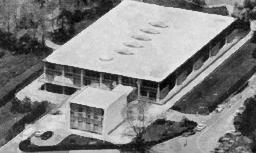1959-1960

 The Jacob A. and Bertha Goldfarb Library
The Jacob A. and Bertha Goldfarb Library
The campus building boom continued as the Jacob A. and Bertha Goldfarb Library opened in time for the 1959-1960 academic year. The library housed a collection that had already grown to 156,360 volumes. This was the first completely new facility built for the university libraries.
—Susan V. Wawrzaszek, Assistant to the University Librarian;
—Staff
Under the leadership of Dean Charles Schottland, the Florence Heller School for Advanced Studies in Social Welfare opened the doors to its first graduate students. In addition to Dean Schottland, the distinguished faculty included Professers David French, Howard Freeman and Robert Morris. Classes met in Woodruff Hall, the cottage that had until recently housed the Brandeis administration.
—Prof. Kenneth J. Jones, Heller School
Heller School Professor Emeritus Robert Morris reflects on the program's mission and formation
Although publicly announced plans for the Heller School declared that it would offer a Doctor of Social Work, emphasizing the practical application of social policy, as well as the PhD, the school offered only the PhD. It was not a school of social work, an impression it has been hard to correct. It did draw many social workers, but also physicians, nurses, sociologists and economists and policy types interested in advanced doctoral study and research in many aspects of health and welfare. The decision to name it a School of Social Welfare (not Social Work, with its emphasis on clinical practices such as personal counseling) meant that its reach covered many aspects of national social policy and public welfare.
Some of the Heller faculty, especially Arnold Gurin and, to a lesser extent I, myself, tried to encourage the growth of the Lown Program. But many professionals in Jewish social agencies never quite accepted the fact that the Heller School was not primarily concentrating on turning out social workers for civil service in Jewish agencies, although several graduates did become Federation executives. In later years, as the School's health policy program matured, it drew younger physicians who acquired a PhD in health policy.
While the first classes met in Woodruff Hall, the school's first offices were in the weight-lifting room of the old gym. We founding faculty completed recruitment of members of the first class, screened them and developed a full year's curriculum in six months. The program has changed over the years, but the foundation laid down in those first hectic and heady months remains in place.
—Robert Morris, Professor Emeritus, Heller School
Brandeis students braved an early March cold-snap to picket Boston-area Woolworths stores. It was a symbolic gesture demonstrating solidarity with the equal rights movement in the south, where stores in the Woolworths chain routinely operated segregated lunch counters.
—Staff
Even as Joe McCarthy receded into the past like the memory of a cold sore, Cold War paranoia continued to make itself felt on the American campus. The National Defense Education Act, an early version of the federal student loan program, required students to sign a loyalty oath before they could collect financial aid. After several weeks of debate, Brandeis students, the faculty and the Board of Trustees decided the university should get out of the oath administration business.
—Staff